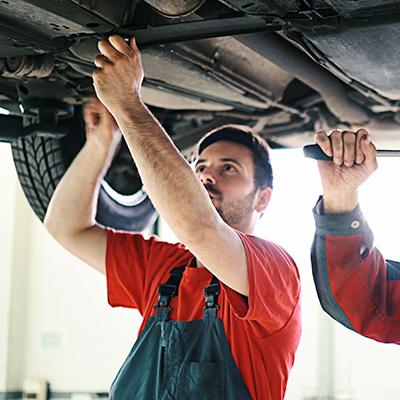- Home
- Services
- Powertrain
- Ball joint boot replacement
Ball joint boot replacement

The rubber housings of the half-shaft joints should be regularly checked for any abrasions, cracks or signs of brittleness. If these appear, the housings should be replaced as soon as possible as they protect one of the most delicate elements of the car - the half-shaft joints - responsible for transmitting the drive at a large angle. If they are penetrated by water or sand, or if their bearings fail, the cost of repair may be very high.
Tips
- have the rubber housings inspected during each periodical check-up
- have them replaced before any cracks or abrasions appear on them. If you notice that the housings are going brittle, have them replaced
- the external housings located on the wheels’ side are those which fail most often
- replacing the rubber housings is not easy, but they are not expensive to buy
Scope of services
- removing the wheels
- removing the MacPherson strut (unscrewing the track rod ends, removing the swing arm pin)
- sliding the half-shafts out of the hubs and the gear box
- removing the joints
- replacing the housings
- adding lubricant
- fitting new housings
- fitting the half-shafts in the hubs and the gear box
- refitting the MacPherson strut
- refitting the wheels
Find a car workshop
Check out our workshops that offer the service ball joint boot replacement in some of the biggest cities in your country
Additional info about the service
What is a CV Joint?
A CV joint is a part of the half-shaft allowing it to change its operating angle while continuing the transmission of the drive. This is required to ensure the upward and downward movement and the turning of the wheels relative to the motionless drive unit. Due to their function, CV joints are frequently referred to as homokinetic joints. CV joints are sensitive to corrosion and require lubrication, hence they are placed in a rubber housing filled with a lubricant.
When should a CV joint be changed?
If such rubber housing is torn or cracks, the lubricant leaks out of it and water, sand and other contaminants make their way to the joint, causing corrosion and damage to its working surfaces, as well as a play and a knocking noise during turning, and, ultimately, its collapse. If you discover any damage to the rubber housing, you should have it replaced with a new one immediately to prevent damage to the joint. Replacing the housing of an internal joint requires removing the half-shaft, detaching the suspension and sliding the outer end of the housing out of the hub. Next, the half-shaft can be slid out of the transmission unit.
What to keep in mind
Replacement of an external joint housing does not require removing the half-shaft from the car, however, it still requires detaching the suspension and separating the half-shaft from the hub. A new housing should be filled with a lubricant, and new mounting bands should be applied. This is a perfect opportunity to check the housings of the other CV joints.